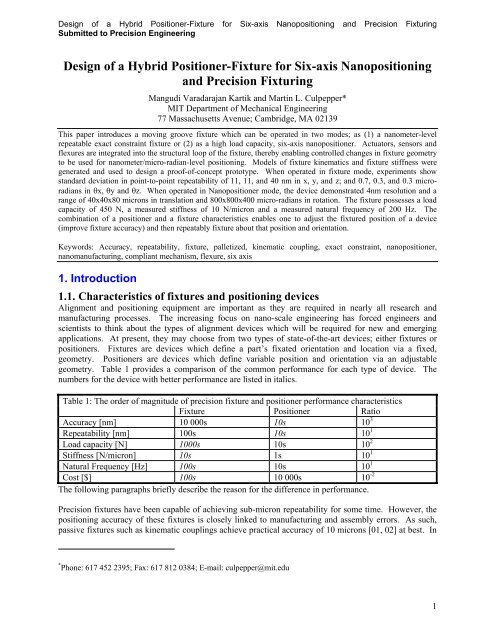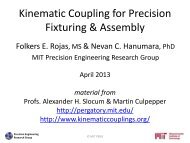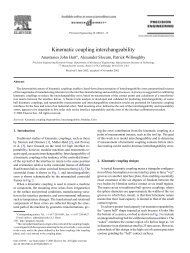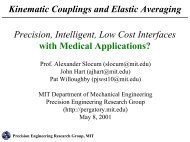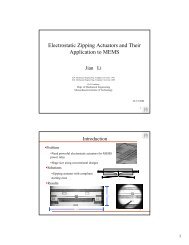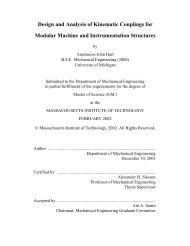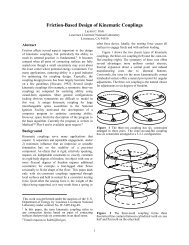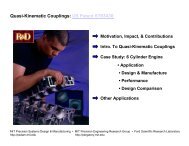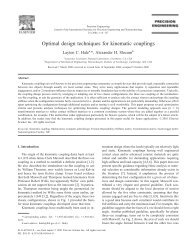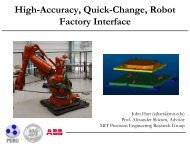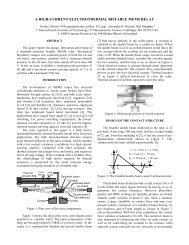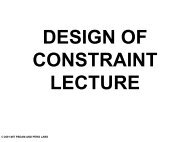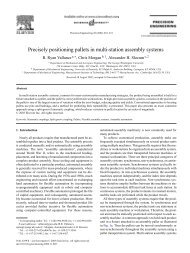Design of a Hybrid Positioner-Fixture for Six-axis Nanopositioning ...
Design of a Hybrid Positioner-Fixture for Six-axis Nanopositioning ...
Design of a Hybrid Positioner-Fixture for Six-axis Nanopositioning ...
You also want an ePaper? Increase the reach of your titles
YUMPU automatically turns print PDFs into web optimized ePapers that Google loves.
<strong>Design</strong> <strong>of</strong> a <strong>Hybrid</strong> <strong>Positioner</strong>-<strong>Fixture</strong> <strong>for</strong> <strong>Six</strong>-<strong>axis</strong> <strong>Nanopositioning</strong> and Precision FixturingSubmitted to Precision Engineering<strong>Design</strong> <strong>of</strong> a <strong>Hybrid</strong> <strong>Positioner</strong>-<strong>Fixture</strong> <strong>for</strong> <strong>Six</strong>-<strong>axis</strong> <strong>Nanopositioning</strong>and Precision FixturingMangudi Varadarajan Kartik and Martin L. Culpepper*MIT Department <strong>of</strong> Mechanical Engineering77 Massachusetts Avenue; Cambridge, MA 02139This paper introduces a moving groove fixture which can be operated in two modes; as (1) a nanometer-levelrepeatable exact constraint fixture or (2) as a high load capacity, six-<strong>axis</strong> nanopositioner. Actuators, sensors andflexures are integrated into the structural loop <strong>of</strong> the fixture, thereby enabling controlled changes in fixture geometryto be used <strong>for</strong> nanometer/micro-radian-level positioning. Models <strong>of</strong> fixture kinematics and fixture stiffness weregenerated and used to design a pro<strong>of</strong>-<strong>of</strong>-concept prototype. When operated in fixture mode, experiments showstandard deviation in point-to-point repeatability <strong>of</strong> 11, 11, and 40 nm in x, y, and z; and 0.7, 0.3, and 0.3 microradiansin x, y and z. When operated in Nanopositioner mode, the device demonstrated 4nm resolution and arange <strong>of</strong> 40x40x80 microns in translation and 800x800x400 micro-radians in rotation. The fixture possesses a loadcapacity <strong>of</strong> 450 N, a measured stiffness <strong>of</strong> 10 N/micron and a measured natural frequency <strong>of</strong> 200 Hz. Thecombination <strong>of</strong> a positioner and a fixture characteristics enables one to adjust the fixtured position <strong>of</strong> a device(improve fixture accuracy) and then repeatably fixture about that position and orientation.Keywords: Accuracy, repeatability, fixture, palletized, kinematic coupling, exact constraint, nanopositioner,nanomanufacturing, compliant mechanism, flexure, six <strong>axis</strong>1. Introduction1.1. Characteristics <strong>of</strong> fixtures and positioning devicesAlignment and positioning equipment are important as they are required in nearly all research andmanufacturing processes. The increasing focus on nano-scale engineering has <strong>for</strong>ced engineers andscientists to think about the types <strong>of</strong> alignment devices which will be required <strong>for</strong> new and emergingapplications. At present, they may choose from two types <strong>of</strong> state-<strong>of</strong>-the-art devices; either fixtures orpositioners. <strong>Fixture</strong>s are devices which define a part’s fixated orientation and location via a fixed,geometry. <strong>Positioner</strong>s are devices which define variable position and orientation via an adjustablegeometry. Table 1 provides a comparison <strong>of</strong> the common per<strong>for</strong>mance <strong>for</strong> each type <strong>of</strong> device. Thenumbers <strong>for</strong> the device with better per<strong>for</strong>mance are listed in italics.Table 1: The order <strong>of</strong> magnitude <strong>of</strong> precision fixture and positioner per<strong>for</strong>mance characteristics<strong>Fixture</strong> <strong>Positioner</strong> RatioAccuracy [nm] 10 000s 10s 10 3Repeatability [nm] 100s 10s 10 1Load capacity [N] 1000s 10s 10 2Stiffness [N/micron] 10s 1s 10 1Natural Frequency [Hz] 100s 10s 10 1Cost [$] 100s 10 000s 10 -2The following paragraphs briefly describe the reason <strong>for</strong> the difference in per<strong>for</strong>mance.Precision fixtures have been capable <strong>of</strong> achieving sub-micron repeatability <strong>for</strong> some time. However, thepositioning accuracy <strong>of</strong> these fixtures is closely linked to manufacturing and assembly errors. As such,passive fixtures such as kinematic couplings achieve practical accuracy <strong>of</strong> 10 microns [01, 02] at best. In* Phone: 617 452 2395; Fax: 617 812 0384; E-mail: culpepper@mit.edu1
<strong>Design</strong> <strong>of</strong> a <strong>Hybrid</strong> <strong>Positioner</strong>-<strong>Fixture</strong> <strong>for</strong> <strong>Six</strong>-<strong>axis</strong> <strong>Nanopositioning</strong> and Precision FixturingSubmitted to Precision Engineeringcontrast, the active adjustment capability <strong>of</strong> positioners enables them to achieve tens <strong>of</strong> nanometersaccuracy and repeatability.The structure <strong>of</strong> passive fixtures is not constrained by the need to change geometry; there<strong>for</strong>e they may bedesigned with emphasis on high load capacity. The geometry <strong>of</strong> positioners must be variable and so theirstructures require bearings and joints which are orders <strong>of</strong> magnitude less stiff than the continuousstructure <strong>of</strong> a fixture. High stiffness is importance as it improves the disturbance rejection capabilities <strong>of</strong>a machine. For instance, errors caused by external <strong>for</strong>ces and vibrations generally decrease as stiffnessincreases.The improved stiffness characteristics <strong>of</strong> fixtures are in-part responsible <strong>for</strong> their higher naturalfrequencies. In contrast, positioners have lower natural frequencies because they include the additionalweight <strong>of</strong> actuation components and they <strong>of</strong>ten incorporate high-per<strong>for</strong>mance, low-stiffness joints orbearings. In the end, the cost <strong>of</strong> active elements, precision bearings and the need <strong>for</strong> precision assembly<strong>of</strong> mechanisms-actuators-bearings make the cost <strong>of</strong> positioners higher than those <strong>of</strong> passive fixtures.The preceding discussion demonstrates the difficulties which must be overcome to make either devicehave the desirable characteristics <strong>of</strong> both devices. This begs the question, “Might we be able to somehowcombine the concepts <strong>of</strong> the fixture and positioner in a way which enables us to obtain the goodcharacteristics <strong>of</strong> each device and none <strong>of</strong> the bad?1.2. Conceptual approaches to integrating fixture and positioner technologyOne might attempt to synthesize a design in which the functional and physical characteristics <strong>of</strong> thefixture and positioner devices remain separated and the devices are then added in series or parallel. Froma positioning perspective, it would be sufficient to put the two devices in series (e.g. integrate a precisioninterface within the stage <strong>of</strong> a positioner). A part could be roughly aligned using the fixture and thenaccurately oriented and positioned using the positioner. Un<strong>for</strong>tunately, in this serial configuration thefixture and positioner would experience the same loading. As such, the cost, stiffness, load capacity anddynamic characteristics <strong>of</strong> this concept would at best approach those <strong>of</strong> the positioner. On the other hand,the parallel addition <strong>of</strong> a fixture and positioner is inappropriate as this would yield an over constraineddesign containing redundant kinematic chains.A different conceptual approach is required. Toward this end, we have developed a conceptual model andsupporting parametric models <strong>for</strong> a hybrid positioner-fixture (HPFs). The HPF incorporates precisionflexure bearings, exact constraint elements and actuators/sensors. The combination <strong>of</strong> these elementsenables the HPF to achieve passive repeatability <strong>of</strong> tens <strong>of</strong> nanometers and active correction <strong>of</strong> alignmenterrors over a range <strong>of</strong> tens <strong>of</strong> microns and hundreds <strong>of</strong> micro-radians. The key in this approach is to usethe capability <strong>of</strong> flexures to possess high stiffness in directions/orientations and low stiffness in 6-directions/orientations. This allows us to use flexures to simultaneously provide position adjustment in 6- directions and constraint in directions. In this work, the flexure bearings are incorporated into thestructural loop <strong>of</strong> the HPF such that they enable:(1) Positioning: The flexure bearing’s directions <strong>of</strong> high compliance are arranged parallel to the directionsin which we wish to actuate. These directions are laid out so that they do not have a detrimental effect onthe HPF stiffness when a high-stiffness actuator is used in parallel with the flexure.(2) Fixturing: The flexure bearing’s directions <strong>of</strong> high stiffness and high load capacity are aligned withthe vectors <strong>of</strong> <strong>for</strong>ce transmittal through the fixture’s structural loop, thereby enabling high load capacityand stiffness.2
<strong>Design</strong> <strong>of</strong> a <strong>Hybrid</strong> <strong>Positioner</strong>-<strong>Fixture</strong> <strong>for</strong> <strong>Six</strong>-<strong>axis</strong> <strong>Nanopositioning</strong> and Precision FixturingSubmitted to Precision Engineering1.3. Contents <strong>of</strong> this paperIn this paper, we describe the conceptual modeling <strong>of</strong> HPFs and how they may be parametricallymodeled. Experimental results are used to demonstrate the accuracy <strong>of</strong> the parametric models, thecapability <strong>of</strong> the HPF to act as a six-<strong>axis</strong> positioning device (six-<strong>axis</strong> displacements), and its capability toact as a positioner (accuracy and repeatability).2. Linking the characteristics and per<strong>for</strong>mance <strong>of</strong> fixtures andpositioners2.1. Analogy between constraints in fixtures and positioning mechanismsThe fundamental difference between fixtures and positioners is their respective static and variablegeometric/kinematic characteristics. <strong>Fixture</strong>s ideally have static structures while the structure <strong>of</strong>positioners is comprised <strong>of</strong> geometrically variable mechanisms. Any attempt to acquire the desirablecharacteristics <strong>of</strong> both devices must start with an ef<strong>for</strong>t to link the characteristics <strong>of</strong> a fixture’s structureand a positioner’s mechanisms. For small motions, it can be shown that exact constraint fixtures arekinematically equivalent to parallel mechanisms [01]. For example, the right side <strong>of</strong> Fig. 1 shows howthe 6 ball-groove constraints (2 per ball groove joint x 3 grooves) <strong>for</strong>m the same arrangement <strong>of</strong>constraints that exist in a Stewart-Gough plat<strong>for</strong>m.Ball far-field pointConstraintGroove far-field pointsFigure 1: Analogy between the constraints <strong>of</strong> a kinematic coupling and the constraints <strong>of</strong> a Stewart-Gough plat<strong>for</strong>mFrom this analogy we may equate the changing <strong>of</strong> fixture constraints with the actuation <strong>of</strong> a 6 <strong>axis</strong>mechanism. There<strong>for</strong>e, if the position <strong>of</strong> the balls and/or groove may be controlled with respect to thecomponents to which they are attached, we may affect changes in position and orientation between thefixtured components.2.2. HPF conceptAlthough examples <strong>of</strong> two [03] and three [04] axes corrective fixtures exist, we must be able to align insix axes in order to (1) achieve any combination <strong>of</strong> position-orientation and (2) to correct parasiticalignment errors. The only existing, 6 <strong>axis</strong> adjustable coupling, an eccentric ball-shaft design shown onthe right side <strong>of</strong> Fig. 2, is limited to micron-level repeatability and accuracy [01] as a consequence <strong>of</strong>needing rolling element bearings.3
<strong>Design</strong> <strong>of</strong> a <strong>Hybrid</strong> <strong>Positioner</strong>-<strong>Fixture</strong> <strong>for</strong> <strong>Six</strong>-<strong>axis</strong> <strong>Nanopositioning</strong> and Precision FixturingSubmitted to Precision EngineeringLRAShaftLALAFigure 2: Moving groove (left) and eccentric ball (right) HPF designs. LA = linear actuator and LRA =linear-rotary actuatorIn this paper, we investigate an alternate six-<strong>axis</strong> design in which the balls are rigidly attached to theirrespective component while the groove surfaces are actively positioned. This arrangement is shown onthe left side <strong>of</strong> Fig. 2. In this design, the groove surfaces are mounted to bearings which guide themparallel to the plane <strong>of</strong> coupling and perpendicular to the groove’s plane <strong>of</strong> symmetry. At each ballgroovejoint, the in-plane and out-<strong>of</strong>-plane displacements <strong>of</strong> the ball-equipped (top) component withrespect to the groove-equipped component may be achieved as shown in Fig. 3.ez i ig i1 g i2g i1 g i2Figure 3: Groove displacements which induce out-<strong>of</strong>-plane (left) and in-plane (right) displacements <strong>of</strong>the top componentEach i th ball-groove joint is there<strong>for</strong>e capable <strong>of</strong> two independent position inputs, g i1 and g i2 . If thegrooves are laid out to ensure linear independence <strong>of</strong> the groove constraints, the device will have sixindependent position inputs. When these inputs are changed <strong>for</strong> each joint, it becomes possible to controlthe position and orientation <strong>of</strong> the ball-equipped component in six DOF.3. Kinematic modelingIn this section, we discuss the approach used to model the positioning kinematics <strong>of</strong> the HPF.3.1. Relationship between actuator displacement and ball displacementIn this analysis, we treat the grooved component as grounded and the ball-equipped component as mobile.The change in position <strong>of</strong> the balled-component’s coupling centroid is defined by the changes in position<strong>of</strong> the ball centers. Equations 1 and 2 describe the relationship between ball displacement and groovedisplacement <strong>for</strong> ball i.4
<strong>Design</strong> <strong>of</strong> a <strong>Hybrid</strong> <strong>Positioner</strong>-<strong>Fixture</strong> <strong>for</strong> <strong>Six</strong>-<strong>axis</strong> <strong>Nanopositioning</strong> and Precision FixturingSubmitted to Precision Engineeringgi1 gi2 i(1)2and, gi1 gi2z i .tan(2) 2 Subscripts 1 and 2 represent the leftmost and rightmost groove surfaces as seen looking down a vectorwhich lies in the groove’s plane <strong>of</strong> symmetry and which intersects the ball’s center and the couplingcentroid. Displacement <strong>of</strong> the grooves toward the center <strong>of</strong> the ball is assigned positive as thiscorresponds to positive displacement <strong>of</strong> the actuators.3.2. Relationship between ball center displacements and fixture in-planedisplacementsVector-based approaches to fixture design are widely used in robotics, reconfigurable fixture systems andmachine structure design. In precision applications, this approach has been applied to model the micronleveldisplacements and errors in static kinematic fixtures [02], kinematic fixtures with two-<strong>axis</strong>adjustability [03] and six-<strong>axis</strong> exact constraint fixtures [01]. Here, we use a vector-based approach whichuses the projection <strong>of</strong> vector loops on the homed plane <strong>of</strong> coupling to model in-plane fixturedisplacements. This approach is unique in that it enables direct calculation <strong>of</strong> the <strong>for</strong>ward and inversekinematic relationships between motion and actuator input. Three vector loops, one <strong>for</strong> each ball, areconstructed as shown in Fig. 4. In this model, the magnitude <strong>of</strong> vector | r ib |= i , is given by Eqxn. 1.This vector is always perpendicular to the corresponding groove’s plane <strong>of</strong> symmetry.ACBr 3ar 1ar 1b||rr 1br 1br 1cyx r 3br 3cr 2cr 2ar 2bFigure 4: In-plane vector loops <strong>of</strong> the HPF model. Note, each ball-groove joint is pierced by one vectorloopIn Fig. 4, each i th loop consists <strong>of</strong> several vectors which trace a path from the home position <strong>of</strong> the ballequippedcomponent’s coupling centroid (point A) to its displaced coupling centroid (point E). Thevector loops are run through each ball-grove joint. Vectors are differentiated by subscripts ij, where icorresponds to the ball-grove joint number and j corresponds to the vector number. A system <strong>of</strong>equations, represented by Eqxn. 3, may be used to describe the fixture’s in-plane position, Xc, Yc, andorientation, z c .ria r r rrib || ib ic (3)Fig. 5 contains an overlay <strong>of</strong> the vector loop <strong>for</strong> ball-groove joint 1 and the ball-grooves <strong>of</strong> a kinematiccoupling. Points A – E in Fig. 5 correspond to points A – E in Fig. 4.DE5
<strong>Design</strong> <strong>of</strong> a <strong>Hybrid</strong> <strong>Positioner</strong>-<strong>Fixture</strong> <strong>for</strong> <strong>Six</strong>-<strong>axis</strong> <strong>Nanopositioning</strong> and Precision FixturingSubmitted to Precision EngineeringStaticCS GrooveDisplacedCSC r 1br 1b||Dyr x zBr 1ar 1cEr A zFigure 5: Detailed view <strong>of</strong> in-plane kinematic model in relationship to kinematic coupling geometry(top component removed <strong>for</strong> clarity). Note the static coordinate system (CS) and displaced CS. Thecoordinate systems lie at the coupling centroid as calculated from the layout <strong>of</strong> the ball positions whenall r ib = 0.For each loop i, Eqxn. 3 represents the two relationships shown in Eqxns. 4 and 5.LLiaiaiaLibcosiaLibsiniaLiccos icXccos || (4)iaLibsiniaLibcosiaLicsin icYcsin || (5)The variables L ij represent the length <strong>of</strong> vector r ij . In this model ic and z are linked by Eqxn. 6, and L iais equal to L ic .ic ia z(6)When Eqxn. 6 is substituted into Eqxns. 4 and 5, L ic is substituted <strong>for</strong> L ia , and we assume small angleapproximations (sin(z c )~ (z c ) and cos(z c )~1), we obtain the matrix equation provided in Eqxn. 7.101010010101 L L L L L L1c1c2c2c3c3c sin cos sin cos sin cos cos1a sin1a 0 cos2a 0 sin2a 00 cos3a 00 sin3a1a1a002a2a00003a3a Xc L1b sin 1a Yc L1b cos1a z c L2b sin2a L1b|| L2b cos2a L 2b||L3b sin3a L3b|| L3b cos 3aSmall angle approximations are appropriate as the second order effects on position due to angle couplingresult in errors on the order <strong>of</strong> 10 -3 – 10 -6 smaller than the displacements <strong>of</strong> interest. The right side <strong>of</strong>Eqxn. 7 consists <strong>of</strong> the actuation inputs, L ib , and geometry variables. This kinematic relationship isdifferent from previous approaches in that it enables the immediate calculation <strong>of</strong> <strong>for</strong>ward and reversekinematic solutions without iteration.(7)6
<strong>Design</strong> <strong>of</strong> a <strong>Hybrid</strong> <strong>Positioner</strong>-<strong>Fixture</strong> <strong>for</strong> <strong>Six</strong>-<strong>axis</strong> <strong>Nanopositioning</strong> and Precision FixturingSubmitted to Precision Engineering3.3. Relationship between ball center displacements and the fixture’s out-<strong>of</strong>planedisplacementsThe out-<strong>of</strong>-plane displacement, Z c , and rotations, x c and y c , are captured using translations <strong>of</strong> theball centers perpendicular to part containing the grooves [01]. Figure 6 shows the planes <strong>for</strong>med by thehomed and displaced position <strong>of</strong> the ball centers. The motion <strong>of</strong> each ball relative to the homed plate isgiven by Eqxn. 2 as z i .Homedz 1z Ball 1Ball 3Figure 6: Out-<strong>of</strong>-plane vector model <strong>of</strong> HPFz 3Displacedz 2Ball 2Given the location <strong>of</strong> each ball center, one may <strong>for</strong>m an equation <strong>for</strong> the plane containing the ball centersand then solve <strong>for</strong> (1) the location <strong>of</strong> the coupling centroid in z and (2) the orientation <strong>of</strong> the plane asdescribed by its normal vector. Changes in position and normal vector due to the out-<strong>of</strong>-plane balldisplacements, z i , are used to determine the change in Z c , x c and y c [01] The relationshipsbetween ball displacements and fixture displacements are provided in Eqxn. 8 – 10 [01]. Theabbreviations s[] = sin[] and c[] = cos[] have been used in Eqxns 8 – 10. L1.(s[1].z c[1]).(z2 z3) L2.(s[2].z c[2]).(z3 z1) L3.(s[3].z c[3]).(z1 z2)x c (8)L1.L2.s[21] L2.L3.s[32] L3.L1.s[13] L1.(s[1] c[1].z).( z2 z3) L2.(s[2] c[2]. z).( z3 z1) L3.(s[3] c[3].z).( z1 z2)yc (9)L1.L2.s[21] L2.L3.s[32] L3.L1.s[13]Zc1xc.s1 1 L ( z(10)1yc.c)3.4. Implementation <strong>of</strong> kinematic theory in a spreadsheet modelEquations 7 – 10 may be used to provide <strong>for</strong>ward and inverse kinematic solutions <strong>for</strong> six <strong>axis</strong> motions.The theory was incorporated into an Excel spreadsheet (available <strong>for</strong> download atpsdam.mit.edu/tools/index.html) which solves the <strong>for</strong>ward and reverse kinematics <strong>of</strong> a moving grooveHPF. The accuracy <strong>of</strong> the kinematic model was checked by comparing simulated displacements withdisplacements measured from a solid model <strong>of</strong> the HPF. The difference between predicted and measuredresults was less than 5 nanometers/1 radians in each <strong>of</strong> the following scenarios:(1) The planar displacement X c , Y c and z c examples portrayed in X(2) The non-planar displacements, x c , y c and Z c(3) Various combinations <strong>of</strong> planar and non-planar displacements4. Stiffness modeling approachIn this section we provide a brief overview <strong>of</strong> how the stiffness <strong>of</strong> the compliant components are modeledand then combined to <strong>for</strong>m a model <strong>for</strong> the stiffness <strong>of</strong> the HPF.7
<strong>Design</strong> <strong>of</strong> a <strong>Hybrid</strong> <strong>Positioner</strong>-<strong>Fixture</strong> <strong>for</strong> <strong>Six</strong>-<strong>axis</strong> <strong>Nanopositioning</strong> and Precision FixturingSubmitted to Precision Engineering4.1. Ball-groove contactsThe ball-groove contacts are modeled as non-linear springs with stiffness and deflection characteristicsgoverned by Hertzian contact mechanics [05, 06]. The normal and tangential stiffness <strong>of</strong> the contacts isgiven by Eqxns. 11 and 12 respectively.kn12 F R E 3 (11)6n e e F tkt 8r Gc 1 Fn13Where F t is the tangential <strong>for</strong>ce, F n is the normal contact <strong>for</strong>ce, the equivalent radius, R e , is given byEqxn. 13, the contact patch radius, r, is given by Eqxn 14, and the equivalent modulus, E e , is given byEqxn. 15.(12)1R 1 1 e RballR(13)groove 133R er Fn(14)4EeEe1 Eballball1Egroovegroove1It should be noted that the stiffness <strong>of</strong> the contact is dependant upon load, there<strong>for</strong>e stiffness properties <strong>of</strong>the fixture will be dependant upon the magnitude <strong>of</strong> the nesting preload.4.2. Groove flexure bearingsThe need <strong>for</strong> groove flexure bearingsWhy are the groove flexure bearings required? It is important to note that the pattern <strong>of</strong> grooves and ballsmust remain geometrically compatible throughout any actuation. This fact, in combination with thechange we are making to the groove pattern combine to yield the desired displacement <strong>of</strong> the HPF. Inessence, we change the pattern and the coupling attempts to adjust position to maintain geometriccompatibility. A consequence <strong>of</strong> the position adjustment is that the balls must slide along the grooves.The sliding motions are illustrated in Fig. 7. In the figure, the leftmost diagram shows the balls andgroove <strong>of</strong> the coupling. As the top groove is actuated to the left, (noted by motion 1), the bottom ballsmust move along their grooves (noted by motions 2) to maintain geometric compatibility between theball-groove patterns.(15)ActuatedEngaged12 2Instant centerFigure 7: Ball-groove sliding “2” due to actuation motion “1”8
<strong>Design</strong> <strong>of</strong> a <strong>Hybrid</strong> <strong>Positioner</strong>-<strong>Fixture</strong> <strong>for</strong> <strong>Six</strong>-<strong>axis</strong> <strong>Nanopositioning</strong> and Precision FixturingSubmitted to Precision EngineeringAs a result, it is typical to obtain the wear marks shown in Fig. 8. The wear marks along the groove arenoted as “2” in keeping with the sliding descriptions in Fig. 7.2Figure 8: Wear <strong>of</strong> groove interface due to sliding contact, “2” indicates wear from ball sliding alonggrooveThis wear is not desired as it imparts non-predictable, time varying changes in the kinematic loop (thecontact between the balls and grooves) <strong>of</strong> the device. This wear, imparts position uncertainties in fixtureper<strong>for</strong>mance which are on the same order <strong>of</strong> the wear errors.Groove flexure conceptsThe first step in developing a conceptual model which solves this problem is to understand the minimumfunction <strong>of</strong> the groove surface. From Fig. 1, we can see that the groove is only required to <strong>of</strong>fer highstiffness and load carrying capacity normal to the groove surface. To reduce over constraint, the stiffness<strong>of</strong> the ball-groove contact perpendicular to the normal direction should be as small as possible. This canbe accomplished by using a bearing whose stiffness is aligned with the normal contact vector. Thegeneral bearing requirements are as follows:(1) Bearing range parallel to the groove surface <strong>of</strong> at least the positioning range <strong>of</strong> the HPF(2) High normal stiffness, preferably at some factor 10 higher than the ball-flat Hertzian contact stiffness.(3) Stiffness parallel to the groove surface which is at least 10 times lower than the preloaded ball-groovetangential stiffness. The (a) minimizes the de<strong>for</strong>mation and there<strong>for</strong>e stress at the ball-groove contact and(b) ensures that no sliding occurs between the ball and groove.(4) Hysteresis at some desired factor lower than desired positioning resolutionSpecific requirements <strong>for</strong> many precision applications include:(5) Vacuum compatible(6) No supporting equipment costs (e.g. electronics or fluid systems)Flexure bearings are one <strong>of</strong> the few types <strong>of</strong> bearings which are capable <strong>of</strong> satisfying all <strong>of</strong> the precedingrequirements. They have been used in exact constraint devices to minimize friction hysteresis effects atnon-sliding contacts [07], to prevent over constraint in ball-cone fixtures [06, 08] and to enable highstiffnessand sealed contact [09].The question now becomes what type <strong>of</strong> flexure bearings should be used. The bearing must be capable <strong>of</strong>high stiffness in one direction and relatively low stiffness in perpendicular directions. Although one mayuse the <strong>axis</strong>ymmetric hour glass type <strong>of</strong> flexures shown in Fig. 9, the kinematics <strong>of</strong> these flexures leadsthem to travel in an arc, thereby imparting parasitic errors to the kinematics <strong>of</strong> the fixture. It is better tohave a flexure which exhibits no inherent parasitic errors.9
<strong>Design</strong> <strong>of</strong> a <strong>Hybrid</strong> <strong>Positioner</strong>-<strong>Fixture</strong> <strong>for</strong> <strong>Six</strong>-<strong>axis</strong> <strong>Nanopositioning</strong> and Precision FixturingSubmitted to Precision EngineeringFlexureBallFigure 9: Prototype <strong>of</strong> hour glass groove flexure bearing <strong>for</strong> HPFThe flexure bearing concept shown on the left <strong>of</strong> Fig. 10 is capable <strong>of</strong> high stiffness normal to the plane<strong>of</strong> the paper and relatively low stiffness parallel to the pane <strong>of</strong> the paper. In practice, a polished, hardenedsteel plate is bonded to the surface <strong>of</strong> the flexure. The plate surface <strong>for</strong>ms the contacting surface <strong>for</strong> thecorresponding ball. If we assume a sufficient preload is <strong>for</strong>cing the ball into contact with the platesurface, then any attempt by the ball to move along the groove (parallel to the plate surface) will cause theflexure beams to comply. The center span <strong>of</strong> the flexure and the groove plate will travel with the ballalong the groove. As such, the ball and groove will not slide relative to each other [10].Groove plate40 mm1 mmFigure 10: Prototype <strong>of</strong> planar groove flexure bearing <strong>for</strong> HPF14.3 mmFlexure armsGroove flexure modelingThe approach used to model the compliant elements <strong>of</strong> the fixture is summarized in Fig. 11. The generalapproach will be explained below in brief and then described with specific reference to the groove flexurebearing.Identify important sub-componentsStiffness model <strong>for</strong> each component[K i] 6x6= stiffness matrix <strong>of</strong> i th component[C i] 6x6= compliance matrix <strong>of</strong> i th componentMatrices in local coordinate system CS iTrans<strong>for</strong>m ([K i ],[C i ]) to global coordinatesystem CS globalCombine stiffness <strong>of</strong> componentsIf m th ,n th components act in parallel[K mn ] = [K m ]+[K n ],[C mn] = [K mn] -1If m th ,n th components act in series[C] mn= [C] m+ [C] n, [K mn]=[C mn] -1Overall stiffness matrix [K total ]=[C total ] -1Figure 11: Direct stiffness approach to modeling systems <strong>of</strong> rigid and compliant parts10
<strong>Design</strong> <strong>of</strong> a <strong>Hybrid</strong> <strong>Positioner</strong>-<strong>Fixture</strong> <strong>for</strong> <strong>Six</strong>-<strong>axis</strong> <strong>Nanopositioning</strong> and Precision FixturingSubmitted to Precision EngineeringA stiffness matrix and compliance matrix are obtained via the direct stiffness approach as explained byHale [11]. The stiffness <strong>of</strong> each compliant element <strong>of</strong> a flexure is assigned to a local (local to theelement) coordinate system and then trans<strong>for</strong>med into the local coordinate system <strong>of</strong> the flexure. Thecontributions <strong>of</strong> each beam’s stiffness characteristics are then combined (according to parallel or serialarrangements) to <strong>for</strong>m a stiffness matrix and a compliance matrix <strong>for</strong> the flexure. The stiffnesscharacteristics <strong>of</strong> each compliant element (ball-groove contacts, guide flexures and groove flexures) willbe trans<strong>for</strong>med and combined to <strong>for</strong>m a global stiffness matrix <strong>for</strong> the HPF.The groove flexure is modeled as a combination <strong>of</strong> eight beams, as shown in Fig. 12. Each <strong>of</strong> the beampairs 1-8, 2-3, 4-5 and 6-7 are in series, hence compliance <strong>of</strong> the pair equals the sum <strong>of</strong> individualcompliances. This matrix relates the motion vector <strong>of</strong> the guided component at the groove flexure’s localcoordinate system, CS GF , under the influence <strong>of</strong> the motion vector <strong>of</strong> external loads.CS 6CS 2CS GFCS 5yCS 7 CS 4xCS 8 CS 3yxwCS 1Figure 12: Model <strong>of</strong> planar groove flexure with showing local beam coordinates (left) and beam designparameters (right)The compliance matrix <strong>for</strong> a single beam is given in Eqxn. 16. The columns in this matrix correspond tothe rows <strong>of</strong> the load vector: [F x , F y , F z , M x , M y , M z ] T .tL 1 K 0 0 0 00xx1Kyy0aG w t0yzaG w t1Kzyxx1Kyy01K zy0 0 0 1 K zzzzyzCbeam(16)Where:K xxK yyK zz001K1K00000001K000001K0E t w (17)a3E wt (18)34a3E w t (19)34 a3E w ty (20)26 aK z11
<strong>Design</strong> <strong>of</strong> a <strong>Hybrid</strong> <strong>Positioner</strong>-<strong>Fixture</strong> <strong>for</strong> <strong>Six</strong>-<strong>axis</strong> <strong>Nanopositioning</strong> and Precision FixturingSubmitted to Precision Engineering3E w t(21)26 aK yz3E w t(22)26 aK zy3E w tz (23)26 aK y34G wt16t t 3.3614 (24)16a 3 w 12w K xx3E w t (25)12 aK yy3E wtK zz (26)12 aand, t = thickness <strong>of</strong> beam, a = length <strong>of</strong> beam, w = width <strong>of</strong> beam, E = Young’s modulus, and G = shearmodulus. Through this parametric model, it is possible to optimize the stiffness properties, e.g. low indirections <strong>of</strong> desired motion and high in other directions/rotations, by tuning design the flexure’s designparameters.4.3. Guiding flexure bearingThe purpose <strong>of</strong> the guiding flexure is to ensure that the grooves are actuated with smooth motion andalong a linear path. Figure 13 shows the conceptual model in which actuators are mounted into six sets <strong>of</strong>linear flexure bearings, e.g. guide flexure bearings, within a monolithic base. This design simplifiesfabrication <strong>of</strong> the HPF as the base may be cut as a single piece via EDM or abrasive waterjet cutting. Thegeometry <strong>of</strong> the flexures may be biased such that they provide a preload on the actuator in the nonactuatedstate.FlexurePlate mountbolt holesActuatorFlexureMonolithicbaseFigure 13: Top view <strong>of</strong> groove guide flexure bearings as machined within monolithic blockA model <strong>of</strong> the guided flexure bearing is shown in Fig. 14. For a guiding motion range, z, <strong>of</strong> 50µm andbeam thickness, t = 1 mm, ( z / t ) 2 = 0.0025 < 1, there<strong>for</strong>e stress stiffening <strong>of</strong> the beams may be neglectedand the beams may be modeled with linear stiffness properties. The steps used to model the stiffness <strong>of</strong>12
<strong>Design</strong> <strong>of</strong> a <strong>Hybrid</strong> <strong>Positioner</strong>-<strong>Fixture</strong> <strong>for</strong> <strong>Six</strong>-<strong>axis</strong> <strong>Nanopositioning</strong> and Precision FixturingSubmitted to Precision Engineeringthe flexure are identical to those covered <strong>for</strong> the groove flexure. Eqxns. 16 – 26 are also valid <strong>for</strong>modeling <strong>of</strong> the compliant elements in the guiding flexure. The direct stiffness method may again beused to <strong>for</strong>m stiffness and compliance matrices <strong>for</strong> the guiding flexure as a whole. The model may thenbe used to ascertain the optimum size, shape, location and number <strong>of</strong> beams.twN-15 L31y Gz GN642x GCS GFBFigure 14: Model <strong>of</strong> grove guiding flexure bearing with N guiding beamsIn designing this flexure we are interested in (1) setting the center <strong>of</strong> stiffness at the centroid <strong>of</strong> theguiding flexure beams and (2) ensuring that the line <strong>of</strong> action <strong>of</strong> the normal <strong>for</strong>ce, F n , runs through thispoint. This is best understood via inspection <strong>of</strong> Fig. 15. By satisfying the two conditions, we minimizethe amount <strong>of</strong> unwanted rotation the bearing will experience due to the moment caused by the contact<strong>for</strong>ce, F n . The model <strong>of</strong> the groove guide flexure, shown in Fig. 15 was used to derive Eqxn. 27 whichprovides an expression <strong>for</strong> M x as a function <strong>of</strong> design parameters.d 3Groove mountw GFy GFFn½L gf sin()z GFL gfb GrooveM xw GFB flexureCentroid <strong>of</strong> ½L gf cos()guide flexuresFigure 15: Center <strong>of</strong> stiffness model <strong>for</strong> the assembly <strong>of</strong> the guiding flexure bearing, groove mount, andgroove flexureLGFsinwGFB LGF cosMx FnsinwGFcos Fn cosb wGFsin (27)2 2 2The variable b is chosen such that M x = 0, thereby reducing the vertical deflection <strong>of</strong> the guide flexurebearing when the groove contact is loaded. The appropriate value <strong>of</strong> b, <strong>for</strong> = 60 o is shown in Eqxn. 28.bMx0 60 L GF2 sin2coscos2wGFB tan2 60L2GFB3 w2GFB(28)13
<strong>Design</strong> <strong>of</strong> a <strong>Hybrid</strong> <strong>Positioner</strong>-<strong>Fixture</strong> <strong>for</strong> <strong>Six</strong>-<strong>axis</strong> <strong>Nanopositioning</strong> and Precision FixturingSubmitted to Precision Engineering4.4. System stiffness modelingIn modeling the stiffness <strong>of</strong> the HPF, we assume that the groove flexure bearing, the guiding flexurebearing and the ball-groove contacts comprise the major sources <strong>of</strong> compliant de<strong>for</strong>mations. As such,they are modeled as compliant elements, e.g. springs, using the direct stiffness approach. The flexurebearings are modeled as linear compliant elements and the bal-groove joints are modeled as non-linearcompliant Hertzian contacts. Each spring is assigned a local coordinate system. The compliance <strong>of</strong> theflexible parts (e.g. beams) within each element in the element’s local coordinate system is trans<strong>for</strong>medinto reference frame <strong>of</strong> the element and the contributions <strong>of</strong> each flexible part are then combined to <strong>for</strong>ma stiffness matrix <strong>for</strong> the element. The element’s stiffness characteristics are then trans<strong>for</strong>med into theHPF’s coordinate system and then the contributions <strong>of</strong> each element are combined to <strong>for</strong>m a stiffnessmatrix <strong>for</strong> the HPF. This matrix relates the motion <strong>of</strong> one coupled component (the ball-equippedcomponent) with respect to the grounded (groove-equipped component) under the influence <strong>of</strong> externalloads. This model was implemented in Matlab and used to predict the system stiffness as a function <strong>of</strong>fixture preload. The change in stiffness with preload (due to the non-linear ball-groove contact stiffness)may be seen in Table 2.Table 2: Simulated HPF stiffness at coupling centroid – based on Matlab modelPreload Kxx[N/µm]Kyy [N/µm] Kzz [N/µm] Kxx[kNm/rad]Kyy[kNm/rad]Kzz[kNm/rad]450N 21.8 21.8 15.5 50.2 50.2 240.8225N 20.4 20.4 14.6 47.3 47.3 223.045N 16.2 16.2 12.1 39.2 39.2 169.85. HPF designThe HPF kinematic and stiffness models were used to design a prototype moving groove HPF. Thecomponents <strong>of</strong> the prototype are shown in Fig. 16. The structural components and flexures are madefrom 6061 T6 Aluminum. The groove flexures are equipped with a hardened stainless steel plate, called agroove plate, which has been polished to a mirror finish. The plates are bonded to the dorsal surface <strong>of</strong>each groove flexure. The balls are comprised <strong>of</strong> hardened stainless steel which has been polished tomirror finish. The balls are bonded and pressed into brass collars which are in turn bonded and pressedinto the top octagonal fixture plate. It is this plate which may be used to fixture and position other partswhich are attached to it. The six guide flexures have been cut into a monolithic base component whichis made from 6061 T6 Aluminum.Figure 16: Prototype moving groove HPF, fixture envelope is 250mmx250mmx80mmThe cross section <strong>of</strong> the ball-grove joint shown in Fig. 17 illustrates how the grooves, groove flexures andgroove plates are rigidly attached to the monolithic base which contains the guiding flexures. Piezoelectricactuators are integrated in the plane <strong>of</strong> the compliant mechanism such that they are structurally inparallel with their corresponding flexure bearing.14
<strong>Design</strong> <strong>of</strong> a <strong>Hybrid</strong> <strong>Positioner</strong>-<strong>Fixture</strong> <strong>for</strong> <strong>Six</strong>-<strong>axis</strong> <strong>Nanopositioning</strong> and Precision FixturingSubmitted to Precision EngineeringBallCollarPalletClampGrooveplateGroovemountPiezoGrooveflexureBase containingguide flexuresFigure 17: Cross section <strong>of</strong> a moving groove HPF ball-groove jointFigure 18 provides an exploded view <strong>of</strong> the HPF in which the assembled relationship between theindividual components is indicated by the parallel dotted lines.Monolithic basePiezo clampGroove flexureBallPalletFigure 18: Exploded view <strong>of</strong> moving groove HPFGroove platePiezoGroove mountCollarThe models were used to design a HPF with the range characteristics shown in Table 3. The HPF wasdesigned to possess a load capacity <strong>of</strong> 450 N and motion resolution <strong>of</strong> 4nm. Stiffness properties will bediscussed in Section 6.6.Table 3: Maximum design range <strong>of</strong> the moving groove HPF prototypeX[µm]Y[µm]Z[µm]x[µradians]y[µradians]z[µradians]Range ± 25 ± 28 ± 44 ± 480 ± 550 ± 2756. Experiment and discussion <strong>of</strong> resultsExperiments were run in order to produce data which could be used to (1) ascertain the accuracy <strong>of</strong> thekinematic model, (2) understand how to calibrate the HPF, (3) verify that the groove flexures preventrelative sliding between the ball and groove, (4) characterize HPF repeatability in fixture mode, (5)ascertain the accuracy <strong>of</strong> the stiffness modeling and (6) understand the dynamic characteristics <strong>of</strong> theHPF. The following sub-sections provide summaries <strong>of</strong> these experiments and discuss the results whichwere obtained.6.1. Experimental setupFigure 19 shows the fixture mounted within an automated test rig. This test rig is equipped with an airpiston which applies up to 450 N nesting preload. A flexure and a wobble pin between the fixture andpiston were used to decouple <strong>of</strong>f-<strong>axis</strong> preload <strong>for</strong>ces which might be applied by the piston. A dSpacecontrol system, cycles the air piston preload and either acquires readings from six capacitance probes orcontrols the six piezo actuators which position the grooves. High-pressure grease was used at the ball-15
<strong>Design</strong> <strong>of</strong> a <strong>Hybrid</strong> <strong>Positioner</strong>-<strong>Fixture</strong> <strong>for</strong> <strong>Six</strong>-<strong>axis</strong> <strong>Nanopositioning</strong> and Precision FixturingSubmitted to Precision Engineeringgroove interface to reduce settling time <strong>of</strong> the fixture. The setup was placed on an air table and allowedto come to thermal equilibrium within an insulated enclosure. The uncertainty in the measurement systemvaried <strong>for</strong> the type <strong>of</strong> test run, these numbers are reported separately <strong>for</strong> each test.BaseGrooveflexuresDecouplingflexureFigure 19: Test stand used to characterize HPF per<strong>for</strong>mancePalletBall6.2. Positioning: Open-loop per<strong>for</strong>mance in a non-calibrated stateDisplacement tests were run to characterize the fixture’s ability to provide pure displacement in each <strong>axis</strong>.The tests were run prior to calibration and without feedback control. Five positions were measured pertest, one at the home position and two on either side <strong>of</strong> home. Between each position measurement, thepreload was removed, the grooves were actuated to the desired position and then the preload wasreapplied. The control/data acquisition was programmed to permit the fixture to settle <strong>for</strong> 30 seconds.Ten readings at each position were taken, and then averaged to obtain the final data point. Theuncertainty <strong>of</strong> the measurements in this experiment was 60 nm. The displacements and parasitic errorsmeasured in each test are provided in Fig. 20 and Fig. 21. The dotted line in the figures has a slope <strong>of</strong>unity and pierces the origin. If no errors are present between commanded and measured displacement, thedata points should lie on this line.16
<strong>Design</strong> <strong>of</strong> a <strong>Hybrid</strong> <strong>Positioner</strong>-<strong>Fixture</strong> <strong>for</strong> <strong>Six</strong>-<strong>axis</strong> <strong>Nanopositioning</strong> and Precision FixturingSubmitted to Precision Engineering50X displacement2X - Parasitic errors20Measured [m]3010-10-30-50-50 -25 0 25 50Command [m]Error [m]10-1-2-50 -25 0 25 50Command [microns]yzTheta xTheta yTheta z100-10-20Error [radian]50Y displacement2Y - Parasitic errors20Measured [m]250-25-50-50 -25 0 25 50Command [m]Error [m]10-1-2xzTheta xTheta yTheta z-50 -25 0 25 50Command [microns]100-10-20Error [radian]50Z displacement2Z - Parasitic errors20Measured [m]250-25-50-50 -25 0 25 50Command [m]Error [m]10-1-2xyTheta xTheta yTheta z-50 -25 0 25 50Command [microns]Figure 20: Translation tests results which compare the measured vs. commanded HPF behavior (left)and the parasitic errors as a function <strong>of</strong> commanded behavior (right)100-10-20Error [radian]17
<strong>Design</strong> <strong>of</strong> a <strong>Hybrid</strong> <strong>Positioner</strong>-<strong>Fixture</strong> <strong>for</strong> <strong>Six</strong>-<strong>axis</strong> <strong>Nanopositioning</strong> and Precision FixturingSubmitted to Precision EngineeringMeasured [radians]Measured [radians]Measured [radians]5002500-250-500500250x displacement-500 -250 0 250 500Command [radians]0-250-5005002500-250-500y displacement-500 -250 0 250 500Command [radians]z displacement-500 -250 0 250 500Command [radians]Error [m]Error [m]Error [m]1050-5-1010-5-10x - Parasitic errorsxyzTheta yTheta z-500 -250 0 250 500Command [microns]50y - Parasitic errors-500 -250 0 250 500Command [microns]1050-5-10xyzTheta xTheta zz - Parasitic errorsxyzTheta xTheta y-500 -250 0 250 500Command [microns]Figure 21: Orientation tests results which compare the measured vs. commanded HPF behavior (left)and the parasitic errors as a function <strong>of</strong> commanded behavior (right)Several linear relationships between the commanded displacement and the parasitic errors may bee seenwithin the parasitic error plots. Some <strong>of</strong> these relationships are denoted on the right sides <strong>of</strong> Figs. 20 and21 by line fits. The linear relationship between command and error is important as it shows thesesystematic errors are well-correlated to the actuation inputs. This opens the door to an elegant calibrationtechnique which will be described later in this section. The systematic errors are in-part due to:020100-10-202010-10-2020100-10-20Error [radian]Error [radian]Error [radian]18
<strong>Design</strong> <strong>of</strong> a <strong>Hybrid</strong> <strong>Positioner</strong>-<strong>Fixture</strong> <strong>for</strong> <strong>Six</strong>-<strong>axis</strong> <strong>Nanopositioning</strong> and Precision FixturingSubmitted to Precision Engineering(1) Geometry errors: The physical components which define the HPFs kinematic chains differ from theideal components which drive the kinematic model. For example there are errors in the reference andaligning features <strong>of</strong> each component which affect the assembly <strong>of</strong> each component. There are also errorsin the size <strong>of</strong> the components which define the HPFs kinematic chains, repeatable parasitic errors in theguide flexures which are due to imperfect geometry <strong>of</strong> the compliant parts, and actuator misalignmenterrors.(2) Material property errors: The model assumes isotropic material properties <strong>for</strong> Aluminum and aYoung’s Modulus <strong>of</strong> 30 ksi Young’s Modulus. It is not uncommon <strong>for</strong> the modulus <strong>of</strong> Aluminum alloyswhich have been <strong>for</strong>med into sheet to differ by 5-10% fro the generic 30ksi value.6.3. Removing systematic errors via calibrationThe calibrated position and orientation vector, PO C , may be related to the model’s predicted position andorientation vector, PO M , via the calibration matrix, C, given in Eqxn. 29. In this approach, we arecalibrating the HPF by modifying the model rather than modifying the hardware.POCXcYcZc C PO MxcyczcCalibratedC11C21C31C41C51C61C12C22C32C42C52C62C13C23C33C43C53C63C14C24C34C44C54C64C15C25C35C45C55C65C16C26C36C46C56C66XcYcZcxcyczcModelThe rows <strong>of</strong> the matrix may be populated using the results <strong>of</strong> the single-<strong>axis</strong> tests. For instance, during anX <strong>axis</strong> move, PO M , would be [Xc, 0, 0, 0, 0, 0] T and the pre-calibrated, experimentally determinedposition and orientation vector, PO E , would be given by Eqxn 30.(29)XcYcZcxcycFor POMzcExperimental [ Xc,0,0,0,0,0]TC Xc11C Xc21C Xc31C Xc41C Xc51C Xc61The slope <strong>of</strong> the lines which were fitted to the data plotted in Figs. 20 and 21 may be used as theconstants, C i1 , <strong>for</strong> the first column <strong>of</strong> the calibration matrix. The same procedure may be used to populatethe 2 nd , 3 rd , 4 th , 5 th , and 6 th , columns using the Yc, Zc, xc, yc, and zc tests respectively. Thecompleted matrix <strong>for</strong> the moving groove HPF prototype is provided in Eqxn. 31.(30)19
<strong>Design</strong> <strong>of</strong> a <strong>Hybrid</strong> <strong>Positioner</strong>-<strong>Fixture</strong> <strong>for</strong> <strong>Six</strong>-<strong>axis</strong> <strong>Nanopositioning</strong> and Precision FixturingSubmitted to Precision Engineering0.9980.013 0.025 0.016 1.000 0.004 0.001 0.007C (31) 0.184 0.950 0.182 1.002 0.016 0.023 0.1740.036 0.0231.0000.6230.110 0.0060.0160.171 0.0310.0010.019 0.003 0.009 0.0200.0011.002 0.0070.0000.003 0.029The improvement due to calibration will depend upon the quality <strong>of</strong> the line fit. Equation 32 shows theR 2 values <strong>for</strong> the calibration. The values R ij correspond to the quality <strong>of</strong> the line fit <strong>for</strong> C ij .1.0000.7541.0020.614 0.639 1.000 0.929 0.997 0.876R (32)0.705 0.963 0.940 1.000 0.785 0.8350.3180.4510.9861.0000.9940.9500.9660.9980.9830.7980.9531.0000.5780.8581.0000.7841.0000.9190.9940.9930.8621.000The errors in the HPF prototype post calibration are listed in Table 4. The first data set indicates howwell the HPF positions <strong>for</strong> a commanded single-<strong>axis</strong> move. The second set looks at the parasitic errors<strong>for</strong> all commanded displacements. In both sets, the numbers in the row labeled “Maximum” are themaximums <strong>of</strong> the absolute value <strong>of</strong> the respective error sets.Table 4: HPF positioning errors post calibrationX Y[nm] [nm]Z[nm]x[radian]y[radian]COMMAND DISPLACEMENT1 14 34 26 0.5 0.4 0.2Maximum 36 93 74 1.6 1.0 0.5z[radian]PARASITIC DISPLACEMENTS1 40 50 321 2.2 1.7 0.7Maximum 140 195 1032 7.4 8.8 2.5The parasitic errors are clearly <strong>of</strong> more concern than the errors in commanded position. In particular, theparasitic errors in the Z <strong>axis</strong> are significantly larger than those in X and Y. The Z errors are larger as thereis poor correlation between command values and some <strong>of</strong> the non-calibrated parasitic Z errors. This canbe seen by inspecting the third row <strong>of</strong> the R matrix. Other parasitic errors (other rows) have several lowR ij values; however the magnitude <strong>of</strong> the errors <strong>for</strong> their good (near unity) R ij values is lower than those<strong>for</strong> Z parasitic errors. A direct link between the hardware and the large magnitude/poor correlation <strong>of</strong> Z20
<strong>Design</strong> <strong>of</strong> a <strong>Hybrid</strong> <strong>Positioner</strong>-<strong>Fixture</strong> <strong>for</strong> <strong>Six</strong>-<strong>axis</strong> <strong>Nanopositioning</strong> and Precision FixturingSubmitted to Precision Engineering<strong>axis</strong> error has not been established. This relationship and other means <strong>of</strong> reducing parasitic errors are amain focus <strong>of</strong> continued work.The non-calibrated model links a vector <strong>of</strong> actuator inputs, A, to the model’s position and orientationvector, PO M , via a trans<strong>for</strong>mation matrix, T. The relationship is shown in Eqxn. 33.POM T A(33)PO M is pre-multiplied by the calibration matrix to remove the linear systematic errors from the system.The resulting relationship, shown in Eqxn. 34, links the design parameters <strong>of</strong> the HPF to the calibratedper<strong>for</strong>mance <strong>of</strong> the HPF.POC C PO C T A(34)MThe calibrated <strong>for</strong>ward and reverse kinematics may then be calculated via normal matrix multiplicationand inversion techniques. Equation 35 shows the solution <strong>for</strong> actuation inputs as a function <strong>of</strong> thecalculated trans<strong>for</strong>mation matrix, the calibration and the desired position and orientation. 1 1A T C PO(35)CThe experimental calibration exercise (six tests) takes less than one hour and is there<strong>for</strong>e a less costly andtime intensive way to achieve better per<strong>for</strong>mance in comparison to the setting <strong>of</strong> tight manufacturing andassembly tolerances. The experimental measurements and subsequent calculations may be automated,thereby making it possible <strong>for</strong> the HPF to be self calibrating over time.6.4. Verification <strong>of</strong> no sliding conditionA test was run to determine if the flexures would prevent relative sliding and stick slip at the ball-groovecontacts. For a preload <strong>of</strong> 225 N, the normal load, F n , on each contact surface is 38-75 N. Thiscorresponds to a tangential contact stiffness <strong>of</strong> 22 N/µm. The maximum tangential <strong>for</strong>ce that may beapplied be<strong>for</strong>e slip occurs is given by F t = µ F n , where µ is the static friction coefficient. For lubricatedsteel on steel, µ = 0.16 and the corresponding tangential <strong>for</strong>ce, F t , is 12 N. The maximum displacementthat may be expected be<strong>for</strong>e siding occurs is 0.5µm. Be<strong>for</strong>e the test run, the HPF was engaged, preloadedto 225 N and then allowed to settle <strong>for</strong> 30 seconds. The HPF was then commanded to move in 4 nmincrements through a range <strong>of</strong> 3 microns. The results in Fig. 22 do not show discontinuities in the plot.This proves that the groove flexures are successfully preventing relative sliding and stick-slip between theballs and grooves.21
<strong>Design</strong> <strong>of</strong> a <strong>Hybrid</strong> <strong>Positioner</strong>-<strong>Fixture</strong> <strong>for</strong> <strong>Six</strong>-<strong>axis</strong> <strong>Nanopositioning</strong> and Precision FixturingSubmitted to Precision Engineering1500Y displacementCommand [nm ]100050000 500 1000 1500Command [ nm ]Figure 22: Displacement test results <strong>for</strong> coupling displacement while balls are engaged in groovesAlthough smooth motion <strong>of</strong> the HPF may be assumed via use <strong>of</strong> the guiding and groove flexure bearings,it is helpful to validate this behavior and understand the smallest motion increment which may beachieved through the HPF. Figure 23 shows a magnified view <strong>of</strong> the rectangular detail in Fig. 22. Thefigure indicates that the engaged resolution <strong>of</strong> the HPF is approximately 4nm. This limit is due tolimitations <strong>of</strong> the electronics that drive the piezo actuators.Measured [ nm ]250225200175Y displacement (detail)Figure 23: Close up <strong>of</strong> rectangular detail in Fig. 22150150 175 200 225 250Command [ nm ]6.5. HPF repeatability in fixture modeOne thousand cycles <strong>of</strong> engagement and disengagement were per<strong>for</strong>med over the course <strong>of</strong> the 14 hourrepeatability test. The HPF was placed in fixture mode, meaning that the actuators were not used toenhance positioning per<strong>for</strong>mance. Positioning occurred solely due to the ball-grove interface interactionsand groove flexure bearing motions. Ideally, the actuators would be commanded to hold their positionthroughout the test. Although the piezos are equipped with internal strain gage sensors which could beused to maintain the position to better than 5nm, the limitations <strong>of</strong> our dSpace system prevent us fromsimultaneously reading six capacitance probes, reading six strain gages and supplying independentvoltages to the six piezos. A compromise approach was implemented in which the piezo actuators wereenergized with a constant voltage during the duration <strong>of</strong> the test. As such, the repeatability data willinclude errors from the piezo actuator creep. The results <strong>of</strong> the test are shown in Fig. 24.22
<strong>Design</strong> <strong>of</strong> a <strong>Hybrid</strong> <strong>Positioner</strong>-<strong>Fixture</strong> <strong>for</strong> <strong>Six</strong>-<strong>axis</strong> <strong>Nanopositioning</strong> and Precision FixturingSubmitted to Precision Engineering2.0X error motion10x error motionX [m]1.00.0-1.0x [radian]50-5-2.00 200 400 600 800 1000Cycle-100 200 400 600 800 1000Cycle2.0Y error motion10y error motionY [m]1.00.0-1.0y [radian]50-5-2.00 200 400 600 800 1000Cycle-100 200 400 600 800 1000Cycle2.0Z error motion10z error motionX [m]1.00.0-1.0z [radian]50-5-2.00 200 400 600 800 1000CycleFigure 24: Repeatability tests with piezo actuators set at constant voltageWe may make several observations from the test results:-100 200 400 600 800 1000Cycle(1) Wear in and long-term stability: Due to the drift – this is clearly seen in the Z data – it is difficult tomake any statements regarding the wear-in behavior <strong>of</strong> the fixture or the long-term stability. These errorsare not a primary concern as they are known to be on the order <strong>of</strong> the surface finish [05] and there<strong>for</strong>ethey may be easily corrected by periodic self-calibration and/or feedback control <strong>of</strong> the actuators.23
<strong>Design</strong> <strong>of</strong> a <strong>Hybrid</strong> <strong>Positioner</strong>-<strong>Fixture</strong> <strong>for</strong> <strong>Six</strong>-<strong>axis</strong> <strong>Nanopositioning</strong> and Precision FixturingSubmitted to Precision Engineering(2) Random errors: Due to the drift min the piezos, the data should be considered in terms <strong>of</strong> short-term(point-to-point, PP) per<strong>for</strong>mance rather than the long-term (absolute, ABS) per<strong>for</strong>mance. Table 5provides the one sigma repeatability in each <strong>of</strong> the six axes <strong>for</strong> PP and ABS.Table 5: <strong>Fixture</strong> repeatability data (values correspond to 1 standard deviation)X[nm]Y[nm]Z[nm]x[radians]y[radians]z[radians]Mates ABS PP ABS PP ABS PP ABS PP ABS PP ABS PP0 - 100 36 14 53 12 68 39 0.60 0.28 0.60 0.28 2.00 0.43700-1000 30 9 34 9 163 35 0.60 0.61 0.60 0.28 2.00 0.270 - 1000 58 11 87 11 288 38 1.4 0.65 1.00 0.29 2.30 0.32The PP values indicate the fixture can be repeatable on the level <strong>of</strong> tens <strong>of</strong> nanometers and fractions <strong>of</strong>micro-radians if actuation inputs remain steady. This level <strong>of</strong> per<strong>for</strong>mance from a passive fixture isthought to be due to elimination <strong>of</strong> ball-groove stick slip. Stick slip prevents the balls from settling intotheir lowest energy state and there<strong>for</strong>e limits the repeatability <strong>of</strong> kinematic couplings [11]. As the ballssettle into the grooves, the balls and grooves slide in the directions indicated by the exaggerated wearpatterns in Fig. 8. The groove flexures prevent the random stick slip phenomena at the ball-groovecontacts, thereby enabling the HPF to settle into a state which is closer to its minimum energy state.Although lubricants can be used to reduce this effect [12] when flexure bearings are not used, such anapproach is limited to non-vacuum applications. We hypothesize that the flexures may also reduce thedependence <strong>of</strong> repeatability on the order <strong>of</strong> engagement <strong>of</strong> the balls and grooves. Both issues are subjects<strong>of</strong> continued work via experiments on kinematic couplings which are not equipped with actuators, butwhich are equipped with the same groove flexures.6.6. Stiffness characteristicsThe fixture was preloaded to provide approximately 7 N/micron stiffness in the x, y and z directions. TheX and Y stiffness were obtained by hanging weights on the distal end <strong>of</strong> a string and attaching theproximal end to the fixture. The string was routed such that the tension in the string was directed parallelto the plane <strong>of</strong> coupling and through the coupling centroid. A comparison <strong>of</strong> predicted and experimentalresults is provided in Table 6. Experimental results show that the fixture is stiffer than expected byapproximately 30 %. This was expected as the modeling approach assumed conservative values <strong>for</strong> thestiffness <strong>of</strong> individual compliant components. A better match between theory and measurement isdesired; there<strong>for</strong>e future work will be focused upon improving the accuracy <strong>of</strong> the model.Table 6: HPF stiffness – experimental vs. analytical resultsKx[N/µm]Ky[N/µm]Experimental 10.0 10.0 10.1Analytical model 7.1 7.1 7.3% error 29.7 29.2 27.9Kz[N/µm]24
<strong>Design</strong> <strong>of</strong> a <strong>Hybrid</strong> <strong>Positioner</strong>-<strong>Fixture</strong> <strong>for</strong> <strong>Six</strong>-<strong>axis</strong> <strong>Nanopositioning</strong> and Precision FixturingSubmitted to Precision Engineering6.7. Dynamic characteristicsAlthough the dynamic characteristics <strong>of</strong> the HPF were not a primary focus <strong>of</strong> this work, tests wereconducted to compare the behavior <strong>of</strong> the HPF with dynamic modeling tools which are underdevelopment. The tests were conducted with a preload <strong>of</strong> 225 N. Figure 25 shows the natural frequencyat 200 Hz <strong>for</strong> a first mode <strong>of</strong> translation in the z directions. The majority <strong>of</strong> the groove-equippedcomponent, e.g. the monolithic base, is physically grounded or directly adjacent to ground during the test,there<strong>for</strong>e the mass <strong>of</strong> the top (e.g. ball-equipped component) comprises the major mass which is free tovibrate. It is possible to reduce the mass <strong>of</strong> this component by 50%, thereby increasing the naturalfrequency up to 40% (280 Hz). If higher frequencies are desired, this can easily be accomplished byincreasing the thickness <strong>of</strong> the guide flexures and increasing the stiffness <strong>of</strong> the ball-groove contacts.Norm. response0 100 200 300 400Frequency [ Hz ]Figure 25: Normalized response <strong>of</strong> HPF dynamic characteristics1.00.507. SummaryIn this paper, we have introduced a hybrid positioning fixture which can be operated in two modes; as (1)a nanometer-level accurate and repeatable exact constraint fixture or (2) as a high load capacity, six-<strong>axis</strong>nanopositioner. Actuators, sensors and flexures are integrated into the structural loop <strong>of</strong> the fixture,thereby enabling controlled, changes in fixture geometry to add nanometer/micro-radian-level positioningcapability. The integration <strong>of</strong> positioning and fixturing functions is made possible by:(a) Ensuring that the flexure bearing’s directions <strong>of</strong> high compliance are arranged parallel to thedirections in which we wish to actuate. These directions are laid out so that they do not have adetrimental effect on the HPF stiffness when a high-stiffness actuator is used in parallel with the flexure.(b) Ensuring that the flexure bearings’ directions <strong>of</strong> high stiffness and high load capacity are aligned withthe vectors <strong>of</strong> <strong>for</strong>ce transmittal through the fixture’s structural loop, thereby enabling high load capacityand stiffness.Models <strong>of</strong> fixture kinematics and fixture stiffness were generated and used to design a pro<strong>of</strong>-<strong>of</strong>-concept,moving groove HPF prototype. When operated in fixture mode, experiments show standard deviation inpoint-to-point repeatability <strong>of</strong> 11, 11, and 40nm in x, y, and z; and 0.7, 0.3, and 0.3 micro-radians in x,y and z. When operated in Nanopositioner mode, the device demonstrated 5nm resolution motionincrement and range <strong>of</strong> 40x40x80 microns in translation and 800x800x400 micro-radians in rotation. Thefixture possesses a load capacity <strong>of</strong> 450 N, a measured stiffness <strong>of</strong> 10 N/micron and natural frequency <strong>of</strong>200 Hz.8. AcknowledgementsThis work was supported, in part, by the Ford Motor Company and the Ford-MIT alliance. The authorswish to thank the alliance and Ford Motor Company <strong>for</strong> their technical and financial support. Thismaterial is based in-part upon work supported by the National Science Foundation under Grant No.25
<strong>Design</strong> <strong>of</strong> a <strong>Hybrid</strong> <strong>Positioner</strong>-<strong>Fixture</strong> <strong>for</strong> <strong>Six</strong>-<strong>axis</strong> <strong>Nanopositioning</strong> and Precision FixturingSubmitted to Precision Engineering0348242. The authors would also like to thank Mr. Gerry Wentworth and Mr. Mark Belanger <strong>for</strong> theef<strong>for</strong>ts in fabricating the fixture prototype.9. References[01] Culpepper, M. L., M. K. Varadajan and M. Dibiaso, “<strong>Design</strong> <strong>of</strong> integrated eccentric mechanisms and exactconstraint fixtures <strong>for</strong> micron-level repeatability and accuracy,” Precision Engineering, 29 (1), 65 – 80,January 2005.[02] Barraja, M. and Vallance, R. Tolerance Allocation <strong>for</strong> Kinematic Couplings, Proceedings <strong>of</strong> the 2002 ASPESummer Conference, July 2002.[03] Taylor, JB, and Tu, JF Precision X-Y Microstage with maneuverable kinematic coupling mechanism, Prec Eng,April, 1996, vol. 18, No. 2, p.85 – 94.[04] Chui, MA, Roadmap <strong>of</strong> mechanical systems design <strong>for</strong> the semiconductor automatic test equipment industry,MIT Ph.D. thesis, 1998.[05] Slocum A. <strong>Design</strong> <strong>of</strong> Three-Groove Kinematic Couplings. Prec Eng 1992;14;67-73.[06] Hale, LC., Principles and techniques <strong>for</strong> designing precision machines, MIT Ph.D. Thesis, 1999, Cambridge,Ma.[07] Schouten CH, Rosielle PCJN, Schellekens PHJ. <strong>Design</strong> <strong>of</strong> a kinematic coupling <strong>for</strong> precision applications. PrecEng;20;46-52.[08] Culpepper, M. L., “<strong>Design</strong> <strong>of</strong> Quasi-Kinematic Couplings,” Precision Engineering, 28 (3), 338 – 357, July2004.Mangudi, K. and Culpepper, M. L., “Active, Compliant <strong>Fixture</strong>s <strong>for</strong> Nanomanufacturing,” 2004 Annual Meeting <strong>of</strong>the American Society <strong>for</strong> Precision Engineering, Orlando, FL. October 2004, pp 113 – 116.[09] Culpepper, M. L., A.H. Slocum and F. Z. Shaikh, “Compliant Kinematic Couplings <strong>for</strong> Use in Manufacturingand Assembly,” Proceedings <strong>of</strong> the 1998 International Mechanical Engineering Congress and Exposition,Anaheim, CA, November 1998, pp 611 – 8.[10] Mangudi, K. and Culpepper, M. L., “Active, Compliant <strong>Fixture</strong>s <strong>for</strong> Nanomanufacturing,” 2004 AnnualMeeting <strong>of</strong> the American Society <strong>for</strong> Precision Engineering, Orlando, FL. October 2004, pp 113 – 6.[11] Hale LC, Slocum AH. Optimal <strong>Design</strong> Techniques <strong>for</strong> Kinematic Couplings. Prec Eng;25;114-27.[12] Slocum AH, Donmez A. Kinematic couplings <strong>for</strong> precision fixturing- Part 2: Experimental determination <strong>of</strong>repeatability and stiffness. Prec Eng 1988;10;115-2.26


